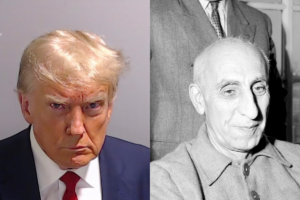For Whom the Bell’s Palsy Tolls
Bell's palsy. It hit suddenly a month ago. I had just stepped off a plane in New York, and my friend noticed the telltale sagging lip. It felt like Novocain. I raced to the emergency room. The doctors prescribed a weeklong course of steroids and antivirals. The following day it got worse. I had to make a decision: Do I host "Democracy Now!," our daily news broadcast, on Monday?Bell’s palsy. It hit suddenly a month ago. I had just stepped off a plane in New York, and my friend noticed the telltale sagging lip. It felt like Novocain. I raced to the emergency room. The doctors prescribed a weeklong course of steroids and antivirals. The following day it got worse. I had to make a decision: Do I host “Democracy Now!,” our daily news broadcast, on Monday? I could speak perfectly well, and I’m tired of seeing women (and men) on TV who look like they just stepped off the set of “Dynasty.” Maybe if they see a person they trust to deliver the news, still there, but just looking a little lopsided, it might change their view of friends and family — or strangers, for that matter — who are struggling with some health issue.
Wikipedia, the popular online encyclopedia anyone can edit, stated that I had suffered a stroke. So on Tuesday I decided to tell viewers and listeners that I was suffering from a temporary bout of Bell’s palsy, that it wasn’t painful and that “the doctors tell me I will be back to my usual self in the next few weeks. In the meantime, it just makes it a little harder to smile. But so does the world.”
Bell’s palsy affects 50,000 people in the U.S. every year. It is an inflammation of the seventh cranial nerve that connects to the eye, nose and ear. The inflammation causes temporary paralysis of the nerve. For some, the eye can’t close, so they have to tape it shut at night, and some can’t speak. George Clooney had it. Ralph Nader came down with it in the midst of a speaking tour. He was in Boston debating someone when his eye started to water and his mouth sagged. It didn’t stop him. He continued his tour, just beginning each talk by saying, “At least you can’t accuse me of speaking out of both sides of my mouth.”
I was just in Santa Fe, N.M., interviewing Tim Flannery, voted 2007 Australian of the Year for his remarkable work as an explorer, paleontologist, zoologist and climate-change scientist. Before we went on the stage, I apologized for my crooked smile. He said he knew the feeling, having had shingles, a more painful viral condition that affects one side of the face. I was beginning to feel less and less alone.
The next day we broadcast from the New Mexico state Legislature. The cameraman told me that Ambassador Joe Wilson, husband of Valerie Plame, had just been in. He had been doing an interview with his wife from a remote studio with Larry King. The cameraman told Wilson that I had Bell’s palsy. He said that he, too, had suffered a bout of it. I caught up with Wilson after our morning broadcast. He described what happened to him. It was 10 years ago. He had just gotten off Air Force One in Africa with President Clinton. He splashed some water on his face, looked in the mirror and saw the telltale face sag, unblinking eye and mouth droop; he thought he had had a stroke. Walter Reed Army Medical Center was called, and Wilson was diagnosed with Bell’s palsy within a few minutes. Clinton sat him down and said that he had known a number of people who had had Bell’s, and that he should just carry on. It would go away. Wilson flew off to Luanda and gave a speech on the tarmac. Later that day, he passed a television set and hardly recognized himself, with his mouth askew. He thought he looked like the actor Edward G. Robinson, a tough-talking gangster speaking out of the side of his mouth.
Even my neurologist once had Bell’s palsy, and said I should just keep working, that, with the medication, it would heal itself. Just to make sure, I visited an acupuncturist in New York’s Chinatown, next to the Off Track Betting Parlor, hearing that the doctor was a good bet!
I’m happy to report the Bell’s palsy is easing up, and I feel fortunate. Fortunate for the waves of support, from the hundreds of e-mails from strangers. A female marketing professor from a Houston business school wrote: “Watching you carry on with Bell’s palsy has taught me a little bit about myself. In real life we encounter people with physical imperfections all the time. Why are we shielded from seeing people with flaws and imperfections on TV? Reporters and anchors on TV news, especially women, typically look as if they just won a beauty pageant or a modeling contest, which seems to add to the disingenuousness of their messages.”
I feel fortunate to have good health insurance, yet feel unfortunate to live in a society where other people’s access to health care is subject to the whims of fortune. The hardest part of this temporary bout has been how tough it is to smile. It has made me realize what a precious gift a smile is. It reminds me of the world’s most famous smile, or, actually, half-smile, the Mona Lisa’s. Perhaps even she had Bell’s palsy.
Amy Goodman is the host of “Democracy Now!,” a daily international TV/radio news hour airing on 500 stations in North America.
© 2007 Amy Goodman
Distributed by King Features Syndicate
Your support matters…Independent journalism is under threat and overshadowed by heavily funded mainstream media.
You can help level the playing field. Become a member.
Your tax-deductible contribution keeps us digging beneath the headlines to give you thought-provoking, investigative reporting and analysis that unearths what's really happening- without compromise.
Give today to support our courageous, independent journalists.









You need to be a supporter to comment.
There are currently no responses to this article.
Be the first to respond.